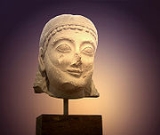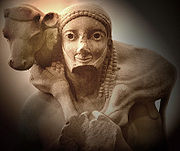
Archaic smile
Encyclopedia

Realism (arts)
Realism in the visual arts and literature refers to the general attempt to depict subjects "in accordance with secular, empirical rules", as they are considered to exist in third person objective reality, without embellishment or interpretation...
, the smile is flat and quite unnatural looking, although it could be seen as a movement towards naturalism. One of the most famous examples of the Archaic Smile is the Kroisos Kouros
Kroisos Kouros
The Kroisos Kouros is a marble kouros from Anavyssos in Attica which functioned as a grave marker for a fallen young warrior named Kroísos. The free-standing sculpture strides forward with the "archaic smile" playing slightly on his face. The sculpture is dated to c. 540-515 BC and stands 1.95...
.
The dying warrior from the west pediment of the Temple of Aphaia, Aegina, Greece is an interesting context as the warrior is near death.
In the Archaic
Archaic period in Greece
The Archaic period in Greece was a period of ancient Greek history that followed the Greek Dark Ages. This period saw the rise of the polis and the founding of colonies, as well as the first inklings of classical philosophy, theatre in the form of tragedies performed during Dionysia, and written...
Period of Ancient Greece
Ancient Greece
Ancient Greece is a civilization belonging to a period of Greek history that lasted from the Archaic period of the 8th to 6th centuries BC to the end of antiquity. Immediately following this period was the beginning of the Early Middle Ages and the Byzantine era. Included in Ancient Greece is the...
(roughly 600 BCE to 480 BCE), the art that proliferated contained images of people who had the archaic smile.
During those 2 centuries before the mid-5th century BCE, the archaic smile was widely sculpted, as evidenced by statues found in excavations all across the Greek mainland, Asia Minor, and on islands in the Aegean Sea
Aegean Sea
The Aegean Sea[p] is an elongated embayment of the Mediterranean Sea located between the southern Balkan and Anatolian peninsulas, i.e., between the mainlands of Greece and Turkey. In the north, it is connected to the Marmara Sea and Black Sea by the Dardanelles and Bosporus...
. It is a smile which, to some modern interpreters, suggests a feeling of happiness via ignorance. It has been theorized that in this period, artists felt it either represents that they were blessed by the gods in their actions, thus the smile, or that it is similar to pre-planned smiles in modern photos.

It has also been suggested that it is simply the result of a technical difficulty in fitting the curved shape of the mouth to the somewhat blocklike head typical of Archaic sculpture.
There are alternative views to the archaic smile being "flat and quite unnatural looking". This is how John Fowles
John Fowles
John Robert Fowles was an English novelist and essayist. In 2008, The Times newspaper named Fowles among their list of "The 50 greatest British writers since 1945".-Birth and family:...
describes the archaic smile in his novel The Magus
The Magus (novel)
The Magus is the first novel written by British author John Fowles. It tells the story of Nicholas Urfe, a teacher on a small Greek island...
(Chapter 23): "...full of the purest metaphysical good humour [...] timelessly intelligent and timelessly amused. [...] Because a star explodes and a thousand worlds like ours die, we know this world is. That is the smile: that what might not be, is [...] When I die, I shall have this by my bedside. It is the last human face I want to see."

